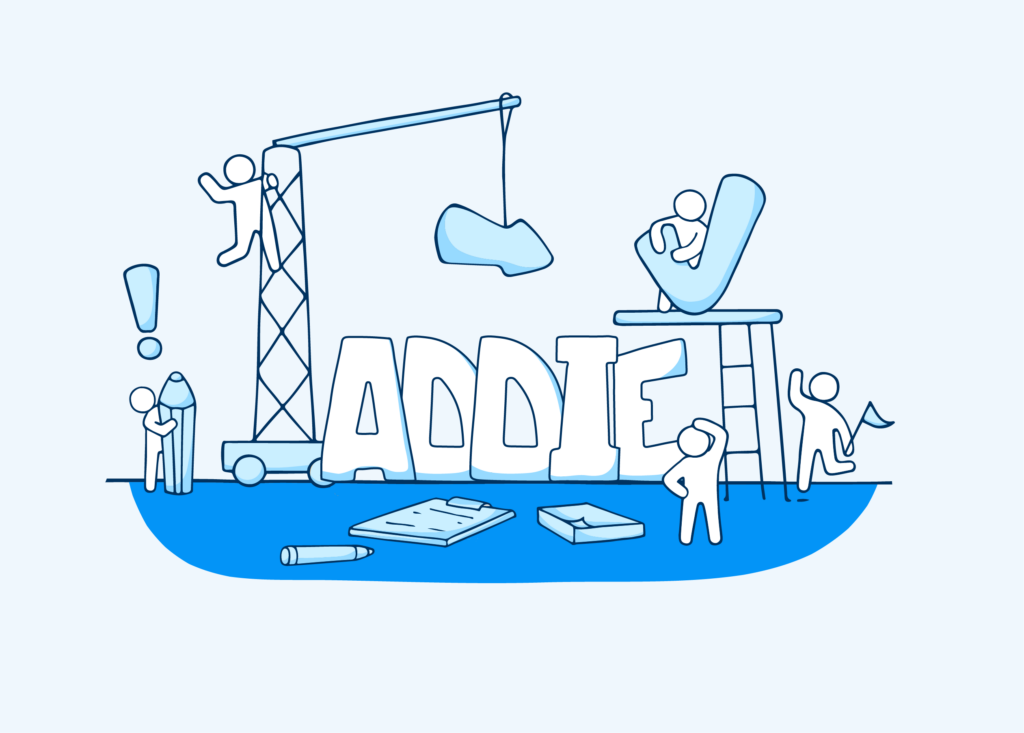This e-Learning ADDIE article describes a step-by-step process for implementing a formal instructional design process. This model can be applied to nearly any form of training including instructor-led, self-paced eLearning, blended training programs, and more. The steps within the ADDIE model for e-Learning include:
Analysis > Design > Development > Implementation > Evaluation
NOTE: Contact the eLearning Network® if you need consultation services or job aids to help you implement the ADDIE model within your organization.
Login for free and Download our free ADDIE Checklist.
e-Learning ADDIE Analysis Phase
During the analysis phase, instructional designers identify the organization’s goals (what training problem is being solved). From there, learning objectives can be established and tied to these training goals. Instructional designers also consider the learning environment (on-the-job, in the field, online, in a classroom, etc.) and the existing knowledge and skills learners might or must already possess prior to engaging in a new “training intervention”. Below are some common elements that are addressed during the analysis phase:
- What is the time line for project completion?
- Describe the target learner/audience
- What new skills/job behaviors are desired?
- What will be the training modality? (online, instructor-led, blended, etc.)
- What kinds of course authoring tools will be used? (Flash, Captivate, Articulate, PowerPoint)
- What kinds of barriers may exist? (low bandwidth, no speakers on computers, etc.)
- Are there any online pedagogical or Adult Learning Theory considerations?
e-Learning Addie Design Phase
During the design phase, the instructional designer:
- Aligns learning objectives to tests, quizzes, interactivities, etc. Tests are essentially learning objectives expressed in the form of a question that, if answered correctly, indicate that knowledge has been successfully transferred.
- Reviews any existing source material for the given subject and performs analysis on this content. The objective is to create a lesson plan and identify existing media (and gaps) such as graphics, animations, illustrations, audio/video files, and other “digital assets”. Document the project’s instructional, visual and technical design strategy by taking into account the existing content and the target audience, and select the most appropriate technologies and audio/visual layout for the project. For some projects, a simple PowerPoint with audio may suffice (Articulate), while for others, a Flash-based visually rich and highly interactive approach may be appropriate.
- Establish the course flow by creating a course outline that includes a lesson plan, table of contents, learning objectives, interactivity points, and so on.
- Select and apply the most appropriate instructional design strategies according to the intended behavioral outcomes by domain (cognitive, affective, and psychomotor).
- Create a mock up of the player interface (pause, play, table of contents, etc.) and the content area (on screen text, images, etc.) for use in the production of a prototype.
- Create a prototype, which is a rough-draft version of the proposed content format. For eLearning, this may include outputting a course using the selected course authoring tool (Flash, Captivate, Camtasia, Articulate, etc.) and covering each of the various page types including introduction, lesson, quiz, interactivity, etc.
- Obtain sign-off from authorized person(s) within your organization (project director, subject matter experts, selected eLearning focus group participants, etc.) Sign-off is critical. If you do not receive sign-off, continue to modify the prototype and instructional design until the prototype reaches or exceeds a minimum level of acceptability.
e-Learning ADDIE Development Phase
During the development phase, instructional designers and developers:
- Create and assemble the content assets (audio, visuals, etc.), created during the design phase, into storyboards which are documents that compile the content (narration), graphics, media developer notes, and so on.
- Develop the multimedia into its final form. Content authors and programmers work to develop and/or integrate the eLearning software tools selected (e.g. Articulate, Flash, Rapid Intake ProForm, etc.)
- Test the content by using appropriate debugging tools.
- Review the project and revise according to any feedback given.
e-Learning ADDIE Implementation Phase
During the implementation phase, instructional designers:
- Upload the content into the selected distribution method. For eLearning, this includes the Learning Management System and generally involves uploading the course as an AICC or SCORM-compliant package, launching the course, and confirming that it is functioning and tracking properly.
- Develop a procedure for training facilitators (if any) and learners on how to best interact with the program content. “Train the Trainer” sessions should cover the course curriculum, learning outcomes, method of delivery, and testing procedures. Preparation of the learners include training them on new tools (software or hardware), student registration.
- Ensure that the books, hands on equipment, tools, CD-ROMs and software are in place, and that the learning application or website is functional.
e-Learning ADDIE Evaluation Phase
After implementation, your course will have generated useful statistical data that should be evaluated to determine how well your eLearning course is reaching the organization’s objectives. This process is both formative and summative.
Formative evaluation is present in each stage of the ADDIE process. Formative evaluation is a bit more complex than summative evaluation. It is done with a small group of people to “test run” various aspects of instructional materials. For example, you might survey learners to provide feedback regarding whether they find the course graphically pleasing, if there are errors in the content that were overlooked, if it has navigational problems, etc. At times, you might need to have this help from a target audience.
Summative evaluation validates or identifies problems with the courseware’s ability to meet quantifiable objectives. For example, did the learners learn the content and demonstrate mastery by passing quizzes, tests, and interactivity? Summative evaluation is typically quantitative, using numeric scores or letter grades to assess learner achievement. Upon completion of the evaluation phase, the course can be modified by following an abbreviated form of the ADDIE cycle. It is abbreviated because the bulk of the work is already completed and your goal now is to refine the product.
